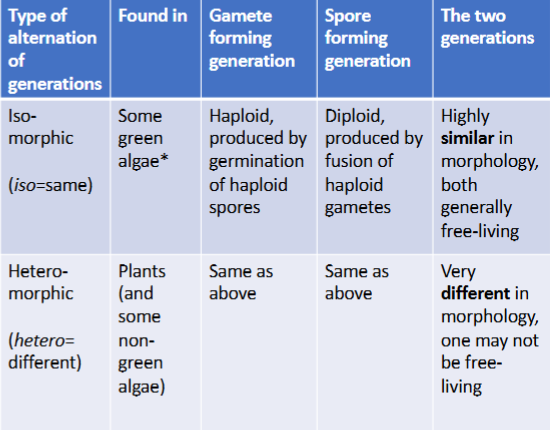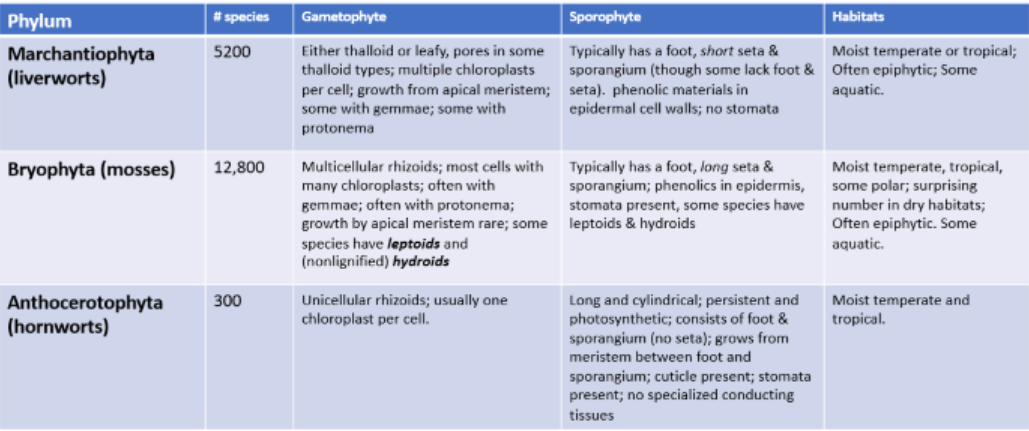bryophytes (271)
1/18
Earn XP
Description and Tags
week 2 - lack of vascular tissue
Name | Mastery | Learn | Test | Matching | Spaced |
|---|
No study sessions yet.
19 Terms
what are bryophytes?
plant species that reproduce by spores rather than flowers or seeds
include: mosses, hornworts, liverworts
In what ways are bryophytes transitional between the Charophycean [green algae] and vascular plants?
Similarity with charophytes: plasmodesmata present, sporopollenin produced, egg retained in oogonium (matrophic)
Different: in charophytes, there is no alternation of multicellular generations, different life cycle that bryophytes, cygote undergoes meiosis so 2n phase is short lived
Charophytes rely on water for sperm movement, bryophytes still dependent on water for reproduction but advancement of having reproductive organs like antheridia and archegonia
How are green algae related to plants (cousins) → similarities and differences?
similar: use chlorophyll a and b, starch stored in plastids, cellulose in cell walls, paired flagella
different: many unicellular (algae), those multicellular generally filamentous or filmy, sex organs generally lack sterile cells, lack heteromorphic alternation of generations
embryophytes
land plants
include mosses, hornworts, liverworts, lycophytes, ferns, gymnosperms, angiosperms
what feature of embryophytes distinguishes it from charophytes. [charophytes closest relatives to embryophytes among green algae]
alternation of generations
embryo protection
growth in specialized regions apical
cuticle (waxy layer covering surface to reduce water loss)
specialized reproductive structures
vascular tissues (in most)
What is the special ecological role of sphagnum and how is that reflected in its anatomy? [what is sphagnum]
genus of moss that grows in wet and boggy areas (also known as peat moss) → create peatlands, preserve remains, holds water and benefits the other plants
Have specialized cells
Good preservative
Good for improving soil, water pH → HAVE RINGLIKE OR SPIRAL WALL THICKENINGS, SURROUNDED BY HIGHLY ELONGATED LIVING CELLS, RICH IN CHLOROPLAST, sphagnum’s weight can be >95% water
Dominate peatlands in north temperate and polar zones
plasmodesmata
cell structure within plants that mediate direct cell-to-cell communication between neighboring cells (bridges)

Alternation of generation
gametophyte stage = n (haploid)
sporophyte stage = 2n (diploid)

what is the relationship between gametophyte and sporophyte generations in bryophytes? [which is more dominant? go through the cycle]
Gametophyte generation → dominant, larger
sporophyte generation → smaller, dependent on gametophyte
haploid stage (gametophyte stage) germinate and form gametophytes (male and female) → (fertilization occurs in the archegonium) multiple mitosis to form embryo → then form into multicellular sporophyte (diploid) that is attached to female gametophyte → in attached sporophyte, the haploid spores produced via meiosis within the diploid tissue → mature sporophytes will dry and be released getting blown away by the wind, bringing back to the beginning of the cycle [spores will germinate and form multicellular gametophytes]
![<p>Gametophyte generation → dominant, larger</p><p>sporophyte generation → smaller, dependent on gametophyte</p><p>haploid stage (gametophyte stage) germinate and form gametophytes (male and female) → (fertilization occurs in the archegonium) multiple mitosis to form embryo → then form into multicellular sporophyte (diploid) that is attached to female gametophyte → in attached sporophyte, the haploid spores produced via meiosis within the diploid tissue → mature sporophytes will dry and be released getting blown away by the wind, bringing back to the beginning of the cycle [spores will germinate and form multicellular gametophytes]</p>](https://knowt-user-attachments.s3.amazonaws.com/05c4a60d-bc43-485b-a39c-0dfe64274b06.png)
what do gametophytes do the males produce? females?
antheridiophores
archegoniophore
How does sexual and asexual reproduction occur in bryophytes?
vegetative reproduction in some bryophytes can occur via gemmae
water goes into gemmae → germination and growth
Asexually: by fragmentation (vegetative propagation), whereby small pieces of tissue produce an entire gametophyte
Sexually: production of antheridia and archegonia, often on separate male and female gametophytes
sporopollenin
major component of tough outer wall of plant spores and pollen grains
some other bryophyte anatomical features
conducting strands in the seta of moss
protonema in moss (a filamentous structure formed upon spore germination)
protonema [what is it? what is its function]
primary filamentous thalloid stage of gametophyte in mosses and some liverworts. thread-like chain of cells that forms in earliest stage of development of gametophyte (haploid) in moss life cycle.
absorbs nutrients and facilitates branching, lead to the formation of gametophores that produce gametes for sexual reproduction
What distinguishes the three phyla of bryophytes (Marchantiophyta, Bryophyta and Anthocerotophyta) from one another?
Marchantiophyta:
More than 4000 of 5200 species of phylum Marchantiophyta
Abundant in tropics and subtropics, where there is heavy rainfall and high humidity
Grow on leaves and bark of trees and other plant surfaces
Liverworts have two rows of equal-sized leaves and third row of smaller leaves along lower surface of gametophyte
Antheridia generally borne on a short side branch with modified leaves
Developing sporophyte is characteristically surrounded by a tubular sheath known as perianth
Bryophyta: mosses?
Consist of 5 classes (only 3 considered)
Sphagnidae (peat mosses)
Comparative DNA sequences, indicate this diverged early from main line of “moss” evolution
Sexual reproduction involves formatino of antheridia and archegonia at ends of special branches located at tips of moss gametophyte
Andreaeidae (granite moss):
Has slits in capsule for the mechanism of spore discharge
Bryidae (often referred as “true mosses”)
Anthocerotophyta: rosettelike
Most hornwort gametophytes are unisexual
Some anthoceros gametophytes are unisexual, others bisexual
Bisexual gametophytes, development of antheridia usually precedes that of the archegonia
Sporophyte of anthoceros, upright elongated structure consists of a long cylindrical capsule or sporangium
Lacks a seta
The foot penetrates the gametophyte tissue and forms a placenta across which the sporophyte obtain nourishment from the gametophyte

matrophy
form of nutrition provided by maternal gametophyte, such as moss gametophyte providing nutrients to zygote and developing sporophyte
thallus
type of body that is not differentiated into root, stem, or leaf
gemmae
small mass of vegetative tissue, outgrowth of thallus
sporangium
enclosure in which spores are formed